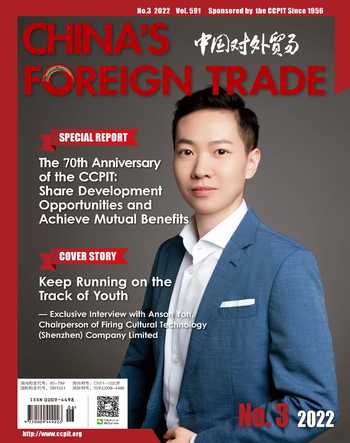China and New Zealand Move to“RCEP+”Cooperation
By Liu Xinwei
This year marks the 50th anniversary of the establishment of diplomatic relations between China and New Zealand. Over the last 5 decades, the two countries have expanded bilateral economic and trade cooperation, recording a number of“firsts” in the relationship between China and developed Western countries, as New Zealand was the first developed country to conclude bilateral negotiations with China on Chinas accession to the WTO, the first to recognize the full market economy status of China, and the first to launch negotiations on and sign a bilateral FTA with China.
On April 7, the Protocol to Upgrade the Free Trade Agreement between the Government of the Peoples Republic of China and the Government of New Zealand (hereinafter referred to as the “Upgrade Protocol”) came into effect, which will further strengthen free trade relations between China and New Zealand on the basis of the FTA and the RCEP, releasing more dividends of opener policies and promoting free and facilitated bilateral trade and investment.
Trade growth rate between China and New Zealand highest in the RCEP region
The FTA between China and New Zealand, which came into force in 2008, was the first FTA signed between China and a developed country. 2019 saw the completion of the transition period and full implementation of all tariff reduction arrangements set in the FTA.
Since the implementation of the FTA in 2018, the bilateral trade of goods between China and New Zealand has grown rapidly at an average annual rate of 11%, with China being New Zealands top trading partner, as well as main export market and source of imports for New Zealand for many years in a row. In 2021, bilateral trade between China and New Zealand reached a new high of USD 24.72 billion, up 36.4% year-on-year, about 5.6 times 2018s bilateral trade volume. From January to February this year, the trade volume between China and New Zealand increased by 22.8% year-on-year, marking the highest rate in the RCEP region.
According to the Ministry of Foreign Affairs and Trade of New Zealand, strong market demand in China has greatly supported the export market of New Zealand and helped improved employment there, with New Zealands products reaching more Chinese families. It was confirmed in a report from the New Zealand Trade for People Advisory Committee that the Chinese market is of great importance to the New Zealand export industry in terms of product quality, nutritional value, food security and so on.
“The New Zealand-China FTA has been a catalyst for the development of trade and economic relations between the two countries. Since it took effect 14 years ago, international FTAs and business practices have changed. Taking the negotiations on FTA upgrade as an opportunity, both sides tried to ensure that the FTA kept pace with the times and benefits importers and exporters and consumers in both countries to the greatest extent possible,” said Clare Fearnley, New Zealands Ambassador to China.
As Fearnley pointed out, the New Zealand government hopes to promote economic recovery through new trade tools and to deal with the impact of the COVID-19 pandemic at a time when the global economy is in turmoil.
Zhao Lijian, spokesman of the Ministry of Foreign Affairs, said that the pandemic is ongoing and leading to weak economic recovery around the world, with an intensifying international situation. The formal establishing of the Upgrade Protocol reflects the determination of both China and New Zealand to support multilateralism and free trade with practical action, which will help maintain the stability of the international industrial chain and supply chain, and positively boost and set a model for cooperation among countries in addressing the challenges of the pandemic, supporting multilateralism and free trade and promoting stable global economic recovery.
“The entry into force and implementation of the Upgrade Protocol will contribute more ‘energy to the China-New Zealand relationship, demonstrating the vitality, resilience and potential of economic and trade cooperation between the two countries, and bringing opportunities for strong post-pandemic economic recovery and long-term sustainable development,” said Chinese Ambassador to New Zealand Wang Xiaolong.
Version 2.0 of the FTA is enriched, bringing dividends to various sectors
Under the China-New Zealand FTA, both sides have achieved a high level of free trade, realizing zero tariff for 97% and 100% of imports respectively. To stabilize and expand the source of imports and promote green and sustainable development, China has promised to gradually eliminate tariffs on 12 taxable items of wood and paper products from New Zealand within 10 years in the Upgrade Protocol, mainly including wood fiberboard, napkins, writing paper, kraft paper, adhesive paper, paperboard and paper labels. Once relevant tariff reduction commitments are fully implemented, 99% of wood and paper products imported from New Zealand into China (about USD 3 billion worth) will enjoy zero tariff.
In terms of trade in services, both countries have made commitments to further lift limits for market access and significantly expand the coverage of favored nation treatment. China has further opened sectors like aviation, construction, maritime transport and finance to New Zealand, especially aviation services, including airport operation services, ground services and professional aviation services which are newlyadded sectors to be opened. Meanwhile, New Zealand will improve openness in legal services, engineering services and other areas, and make new commitments to open up management consulting and related services.
In the field of investment, New Zealand will significantly relax the review restrictions on Chinese investors, giving Chinese investors the same treatment as CPTPP members, and providing more freedom and convenience for new projects in New Zealand by Chinese investors.
In terms of rules of origin, the Upgrade Protocol has perfected the provisions of direct transport, introduced the system of independent declaration of origin for approved exporters, and added clauses for certificate of origin replacement, exemptions from submitting documents of origin and networked verification systems, to significantly facilitate trade enterprises to benefit from the upgraded FTA. At the same time, both countries will also establish committees on rules of origin, to promote more standardized and effective implementation of the rules of origin.
In terms of customs procedures and trade facilitation, both countries committed to quick customs clearance of goods meeting appropriate conditions, especially perishable goods (as quickly as possible, within six hours), improving transparence of trade management documents and recognizing the effectiveness of electronic documents as paper ones, while providing more efficient and effective customs clearance services for enterprises in both countries by utilizing risk management, information technology and other means.
As the New Zealand Herald commented,“The upgraded China-New Zealand FTA is greatly ‘enriched and expanded, updating 2008 version of China-New Zealand FTA.”
E-commerce may provide new opportunities for economic and trade cooperation
The Upgrade Protocol updates the chapter of the original agreement on cooperation, and adds four new chapters on e-commerce, government procurement, competition policy, environment and trade, to set high-quality rules in various economic and trade fields. Among them, e-commerce in particular is believed to bring new opportunities for economic and trade cooperation.
According to an e-commerce report by the New Zealand Post, the volume of online transactions in New Zealand totaled USD 7.67 billion in 2021, setting a new record at 52% higher than that of 2019. Meanwhile, 34% of e-commerce deals in New Zealand in 2021 were paid through credit or recharge cards, followed by digital wallets (20%) and debit cards(16%). As digital payment technology develops, the e-commerce industry in New Zealand is expected to continue to grow by 38% over next three years.
“The epidemic lasts, encouraging New Zealanders to spend more time and money online than ever before, which is evidenced by the record-making amount of packages. During the lockdown, online shopping was the only option for many people, boosting the boom of the e-commerce industry. Today, online shopping is an important part of New Zealanders daily lives, whether the city is locked down or not,” said Chris Wong, commercial marketing general manager of New Zealand Post.
For the e-commerce industry, the Upgrade Protocol incorporates contents like electronic authentication and digital certificates, online consumer protection, online data protection, paperless trade, unsolicited commercial electronic messages and so on, to promote market development through e-commerce for businesses in both countries together, especially with SMEs.
“The Upgrade Protocol is a high-level FTA according to international standards, and it will facilitate cooperation between China and New Zealand in a wide range of economic and trade sectors including digital trade, and mutually improve economic competitiveness in the international market, with a series of new clauses for cross-border cooperation and provisions covering e-commerce,” said a head of the Department of International Trade and Economic Affairs of the Ministry of Commerce.
According to statistics from the WTO, as of March this year, New Zealand has 13 regional trade agreements in force, and it is a member of the CPTPP, the RCEP and other high-standard FTAs, as well as the depositary for the CPTPP and the DEPA, meaning it is experienced in making international economic and trade rules. Li Zhen, assistant researcher at Hainan Institute of Finance, Bank of China, believed that the Upgrade Protocol will not provide experiences and a reference for China to sign and upgrade FTAs with other countries in the future, but also for China to carry out negotiations on the CPTPP and DEPA and to develop RCEP negative lists.
The head of the Department of International Trade and Economic Affairs of the Ministry of Commerce also said: “When it comes to the environment, the Upgrade Protocol sets a higher environmental standard than the RCEP, highlighting the shift of China from commodity and productive factor flow-based opening to rules and system-based opening, and laying a good foundation for China to upgrade FTAs with higher standards and wider coverage.”
- China’s foreign Trade的其它文章
- The Beijing Initiative of the Global Trade and Investment Promotion Summit Was Released
- The 70th Anniversary of the CCPIT:Share Development Opportunities and Achieve Mutual Benefits
- CCPIT Signs MOU on Strategic Cooperation with SINOSURE
- The 2022 Boao Forum for Asia for Global Development and A Shared Future
- China Is Still Regarded As One of the Major Strategic Markets
- China-Thailand Trade Enjoys Multiple Dividends With the Effect of the RCEP

